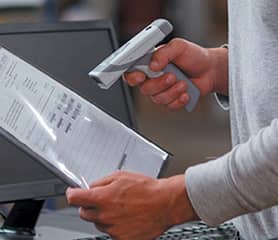Applications
As you strive to meet your business goals, you’re probably considering how RFID asset tracking technology can make you more efficient. Here are a few examples:
Efficient picking
Warehouses and logistics companies can increase forklift picking efficiency with RFID labels. Forklifts can be located quickly, and location detection can take place in real time, at crucial places such as zone changes, or when items are scanned, picked up and dropped off. This data enables pick-up and drop-off location control, efficient route calculation and route registration.
Instant cargo checks
Distribution centers use RFID labels and readers for automated cargo checks. RFID readers can check every component package against the cargo lists in central enterprise resource planning (ERP) systems. Wrong components are easily filtered out, missing pieces are noted and complete shipments are confirmed.
Guided installations
A machine builder can get large devices installed faster with custom RFID labels by guiding installers to
the next package. Linked to digital installation manuals, each package with components is opened only when relevant. If proximity alerts are used, they can help find the smallest of packages needed to get large machines operational swiftly, and decisively.
Preventive maintenance
Rail passenger and freight transporters can increase locomotive and wagon uptime by easily identifying train composition with RFID labels and readers. Each wagon or locomotive can be linked to asset management software via an RFID label. Intervention data can be added to the maintenance history of labeled wagons in the field, and similar wagons can be flagged for efficient preventive maintenance.
Automated inventory audits
A worldwide information, communication and technology (ICT) company tracks and manages the location of every client’s servers and other high-value
IT assets automatically, and can report on their location at the click of a button. Custom, passive RFID labels on every asset combined with fixed readers at all datacenter exits provide accurate, real-time tracking. Print-and-program printers in a central location enable the company to label any new assets immediately with reliable, custom RFID labels to maintain a complete overview.
Secured identification
A full-service ICT infrastructure provider can use secured cable identification data on double-layered, encrypted near-field communication (NFC) labels. On-metal NFC labels can be pre-programmed to include an information top layer for in-house and external professionals, and a deep security data layer accessible for in-house administrators. Professionals who are performing maintenance interventions can be given access to relevant label data using RFID pens linked to their user setup.
Faster safety checks
A large airline carrier flying 100+ destinations can use RFID labels and readers to perform routine aircraft checks up to 10 times faster. Aircraft maintenance crews can scan the cabin against an inventory list to check data on life vests, oxygen generators and masks. Not needing line of sight on every item creates a huge difference in operational speed by freeing up time for the personnel who manage an aircraft.


